Aloe vera, hailed as the “plant of immortality” by ancient Egyptians, is more than just a striking succulent; it’s a powerhouse of health benefits and resilience. With its fleshy green leaves packed with a soothing gel, this versatile plant has found its way into everything from skincare products to smoothies. But how to grow aloe vera?
Step-By-Step Guide On How To Grow Aloe Vera From Leaf
Growing aloe vera from a leaf cutting is surrounded by misconceptions that can frustrate aspiring plant enthusiasts. Many believe that simply planting a leaf will yield new growth. This method is generally ineffective because aloe vera leaves do not contain nodes, the essential points where roots and new shoots can develop. Use offsets or pups, which are small plantlets that grow at the base of an established aloe vera plant.
Preparing The Leaf
To begin your journey of growing aloe vera from a leaf cutting, it’s essential to select a healthy, mature leaf. Look for one that is firm and plump—these are vitality indicators. Once chosen, use a sterile knife or scissors to cut the leaf close to the base, but leave some stem attached.
Drying And Planting The Cutting
After cutting, place the leaf in a dry area away from direct sunlight for about 24 hours; this allows the cut end to callous over and helps prevent rot once planted. Prepare a well-draining potting mix, ideally one designed for succulents or cacti. Place the dried cutting upright in the soil, ensuring that only the healed end is buried while keeping most of the leaf exposed above ground.
Managing Expectations (Slow Rooting Process)
It’s essential to manage your expectations during this process; rooting can be slow, often taking several weeks or months without any visible signs of growth. Patience is key! Regularly check your cutting and ensure it receives bright but indirect light, as too much sun can stress it further while establishing roots. With time and care, your aloe vera will reward you with vibrant growth and abundant benefits.
Step-By-Step Guide On How To Grow Aloe Vera In Pots
It’s essential to choose a vessel with drainage holes. These holes allow excess water to escape, preventing root rot, a common issue with these succulent plants. Choosing a pot made from breathable materials like terracotta can further enhance air circulation around the roots, fostering robust growth.
Selecting a pot with drainage.
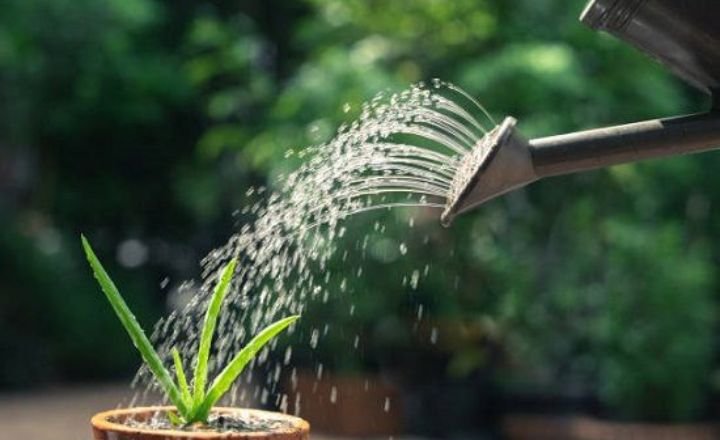
When choosing a pot for your aloe vera, prioritizing drainage is vital to keeping this hardy succulent healthy. Opt for a container with multiple drainage holes; terracotta pots are particularly effective as they allow excess moisture to evaporate, preventing root rot. Consider the size of your pot carefully; it’s tempting to provide abundant space for growth, but a vessel that is too large can lead to overwatering issues in the early stages.
Using A Cactus/Succulent-Friendly Soil Mix
Aloe vera thrives in a cactus or succulent-friendly mix that promotes swift drainage and aeration. You might even create your blend by mixing standard potting soil with sand or perlite, further enhancing drainage while ensuring nutrients remain accessible.
Repotting Tips
As your aloe matures and fills its home, be prepared to report every couple of years. Gently slide it out of its old container and check the roots. If they appear cramped or brown, trim them lightly before transferring them to a slightly larger pot with fresh soil mix. This routine refreshes nutrients and encourages healthy growth, fostering an aesthetically pleasing arrangement that brightens the living space.
Ideal Conditions For How To Grow Aloe Vera Indoors
The ideal conditions for cultivating a thriving aloe vera indoors revolve primarily around light and moisture management. Aloe vera thrives in bright, indirect sunlight, making a south or west-facing window its perfect home.
Light Requirements (Sunlight Vs. Artificial Light)
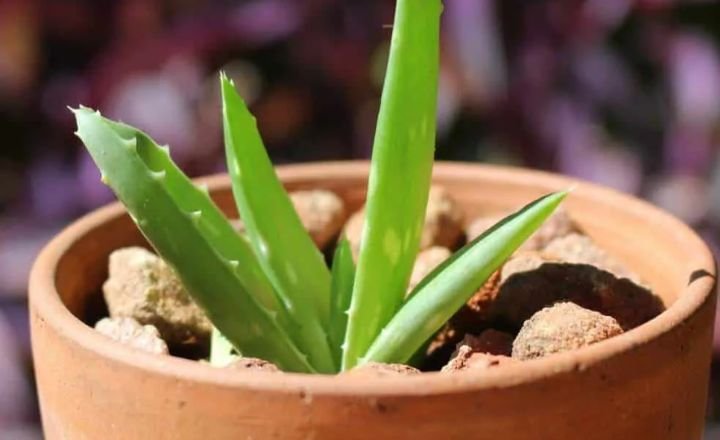
Light is a crucial factor that can affect your plant’s health. These resilient succulents prefer bright, indirect sunlight for 6-8 hours daily. A south or west-facing window offers optimal conditions. Natural light falls short during gloomy days or in dimly lit homes, so consider utilizing full-spectrum grow lights. This alternative mimics the sun’s energy and allows you to extend the daylight hours, promoting photosynthesis and ensuring robust growth.
Temperature And Humidity Considerations
Temperature and humidity also play significant roles in aloe vera care. These plants thrive in warmer climates, with ideal temperatures ranging from 60°F to 75°F (15°C to 24°C). Too much humidity can lead to root rot; therefore, keeping your environment dry is essential. One common pitfall many indoor growers encounter is overwatering. Aloes are adapted for arid conditions and require minimal moisture.
Common Indoor Aloe Vera Care Problems
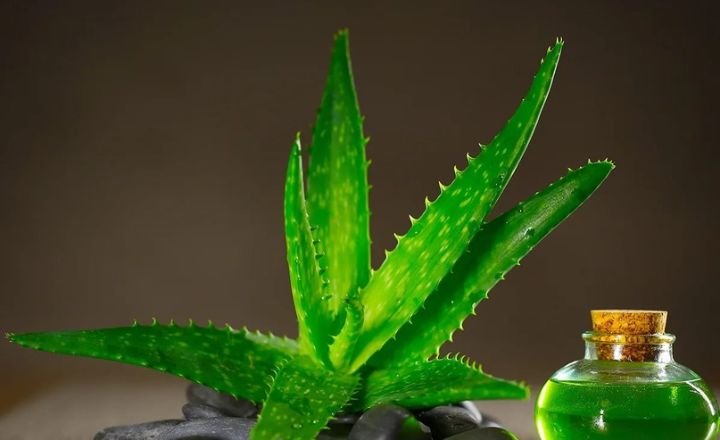
- The most prevalent challenge aloe vera enthusiasts face is overwatering, a mistake that seems counterintuitive for a plant accustomed to arid conditions.
- The telltale signs of rot often manifest through yellowing leaves or an oddly soft texture. Insufficient light can hinder aloe’s natural growth and vigor.
- They can tolerate lower light levels; these plants flourish under bright, indirect sunlight.
- Neglecting pest inspections can lead to severe issues down the line.
- Aloe plants are not immune to infestations from mealybugs or spider mites, a reality often overlooked by beginners.
Regularly inspecting the undersides of leaves for any signs of distress allows you to catch problems early and provides an opportunity for quick intervention using gentle insecticidal soap or neem oil when necessary.
Tips On How To Grow Aloe Vera Fast
Growing aloe vera quickly is not about enjoying its benefits sooner; it’s also a rewarding journey that empowers you as a gardener. Understanding the ideal conditions for your aloe plant can significantly enhance its growth rate.
Ensure your aloe vera receives adequate sunlight to encourage it to reach its full potential. Position your plant where it can bask in bright, indirect light for a significant portion of the day. Direct sunlight for too long can scorch its delicate leaves, so consider rotating the pot occasionally to expose all sides evenly.
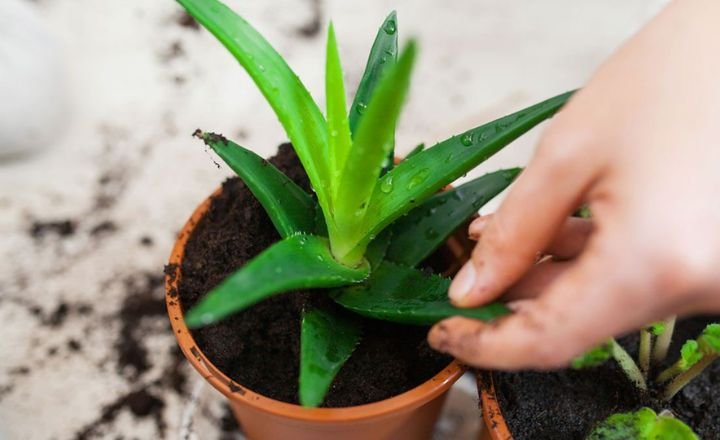
Watering techniques are pivotal in nurturing healthy aloe vera and preventing root rot, a common pitfall for many gardeners. Use the soak-and-dry method, allowing the soil to dry out completely between waterings. This balance helps prevent oversaturation and encourages the plant’s natural drought resistance.
Choosing nutrient-rich soil explicitly designed for succulents enhances growth by providing essential minerals without compromising drainage. A blend with organic matter like compost or coconut coir mixed with perlite or sand will boost aeration and mimic their natural arid habitat.
Detailed Steps On How To Grow Aloe Vera From Cutting
Growing aloe vera from cuttings is a cost-effective way to expand your collection and foster a deeper connection with nature. Unlike starting from seeds, which can be a slow and uncertain process, propelling new life from cuttings offers immediate gratification.
Differences Between Leaf Cuttings And Pups (Offsets)
Leaf cuttings involve slicing a mature leaf into segments, which can sometimes be tricky; they require precise care and favorable conditions to root successfully. This method allows gardeners to propagate new plants using existing ones. There’s an inherent uncertainty due to varying success rates.

Pups are miniature versions of the parent plant that form near its base, making them a more reliable choice for propagation. They come with established roots, assuring a higher success rate when transplanted. This simplifies the propagation process and fosters rapid growth as these offsets already possess essential nutrients from their mother plant.
How To Harvest Pups For Propagation
Harvesting pups, those small offshoots that sprout around the base of a mature aloe plant—is the key to expanding your collection effortlessly. To begin, carefully remove the pup from its mother by digging into the soil and gently detaching it. Ensure that you leave some roots intact for optimal growth; if there aren’t many roots, don’t fret. These resilient plants can thrive even after some pruning.
Let it sit in a dry, shaded area for at least 24 hours to allow the cut end to callous over. This step minimizes the risk of rot when planted. Afterward, transfer your pup into a pot filled with well-draining soil. Succulent mixes or cactus blends work wonders here. Water sparingly and place them in bright but indirect sunlight; this balance will encourage their growth without overwhelming them.
Caring For Pups And Ensuring Their Survival
Caring for the offspring, affectionately known as pups, emerges as an art of balance. These tiny plants thrive on care that mimics their natural arid environment. Water sparingly; wait until the soil is arid before giving them another drink, ensuring you avoid stagnant moisture at all costs. Fertilizing during their growing season with a diluted cactus fertilizer can give pups an extra boost without overwhelming their delicate systems.
How To Grow Aloe Vera In Water
Yes, it is possible to grow aloe vera in water, but there are better methods for health. Aloe vera plants are succulents that thrive best in well-draining soil and are adapted to arid environments. The technique requires a delicate balance, just like for rice growth. The ideal practice is to select healthy, mature leaves or offsets and ensure they have experienced proper drying time before submerging them in water.
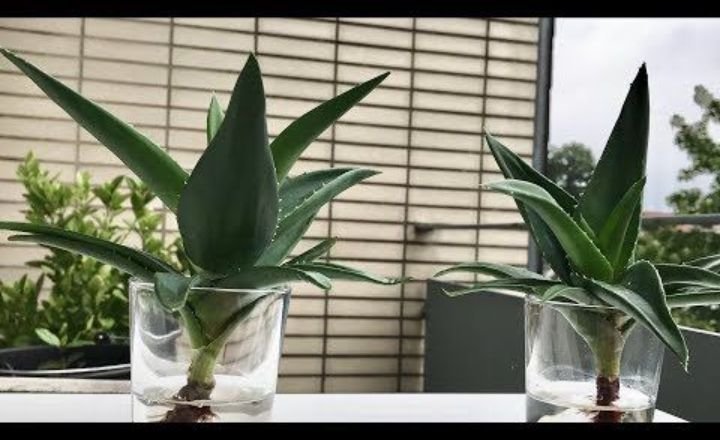
This allows a protective callus to form over the cut surfaces, reducing the risk of rot, a common pitfall for eager planters. Keep water levels low; just enough to cover the base of the leaf can encourage root development, preventing excess moisture that might lead to bacterial growth.
How to Grow Aloe Vera in Water Without Roots
To grow aloe vera in water without roots, select a healthy cutting from a mature plant; aim for a leaf that’s 4 to 6 inches long. Place the cut end in a glass of water, submerging it by about an inch while keeping the rest of the leaf above the surface to prevent rot.
Position your cuttings near indirect sunlight, encouraging photosynthesis while minimizing plant stress during root development.
You can expect to see roots begin to emerge within two to four weeks. Patience is vital; monitor your cutting and replace the water weekly to keep it fresh and clean.
Once established roots measure at least 2 inches long, gently transition your aloe vera into the soil by preparing a well-draining potting mix, preferably one designed for succulents or cacti. This gradual shift helps acclimate your plant and reduces transplant shock, allowing it to thrive as it becomes a robust addition to your home garden.
How to Grow Aloe Vera in 2025: Advanced Cultivation Tips for High Yield
Best Conditions to Grow Aloe Vera
If you’re curious about how to successfully grow aloe vera, it all begins with creating the right environment. Aloe vera loves warm, dry climates and thrives in sandy or loamy soil that drains well. Aim for a pH level between 6.0 and 7.5. Remember, overwatering is a no-go, so make sure your plants have proper drainage to avoid root rot.
Propagation: How to Start Growing Aloe Vera from Offsets
The simplest way to grow aloe vera at home or on a farm is by using offsets, which are the little baby aloe plants. Carefully detach the pups from the mother plant and replant them with about 60×60 cm spacing to give them room to grow strong and healthy.
Watering Aloe Vera: How Often to Water Aloe Vera
Aloe vera is quite drought-tolerant, so deep but infrequent watering is the way to go. Always let the soil dry out completely before you water again. In most areas, watering 4 to 6 times a year should do the trick.
Fertilizers & Soil Nutrients
To boost growth, consider applying organic compost along with a mix of Nitrogen (35 kg), Phosphorus (70 kg), and Potassium (70 kg) per hectare. Adding neem cake can also help protect the soil naturally and enhance your yield.
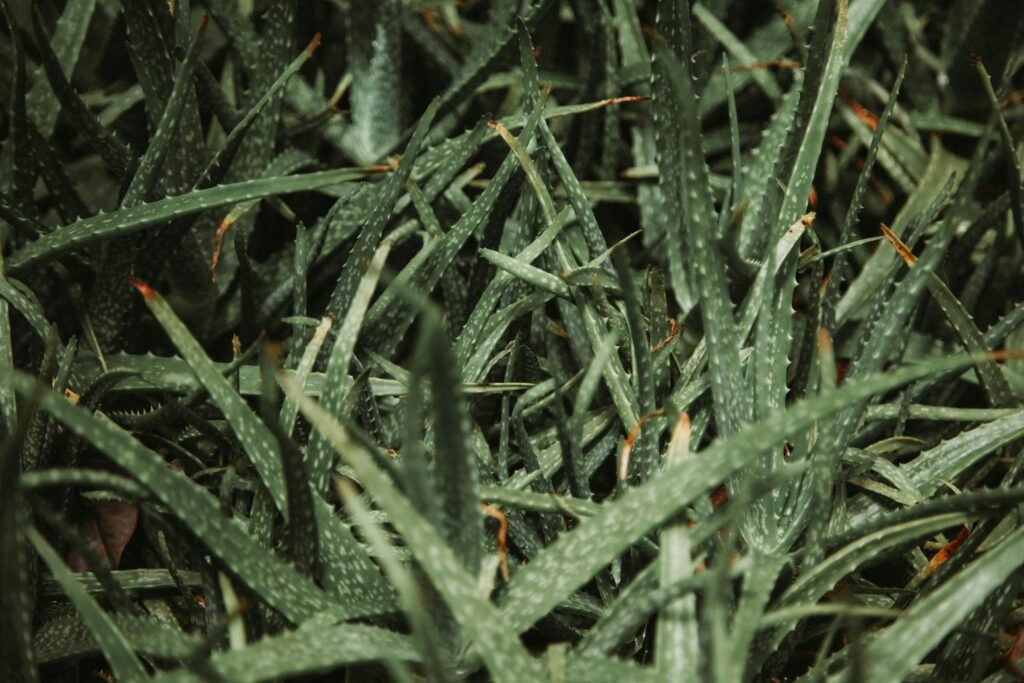
How to Take Care of Aloe Vera Plants
Aloe vera is pretty low-maintenance, but keep an eye out for pests like termites and any leaf spots. Regularly check your plants and use eco-friendly fungicides if necessary. Healthy aloe leaves should be green, thick, and firm.
When & How to Harvest Aloe Vera Leaves
You can start harvesting leaves about 8 to 10 months after planting. Always cut the outer leaves first with a sharp, clean blade. Each plant can be harvested every three months, so you’ll have a steady supply.
Commercial Aloe Vera Farming Tips (International Standards)
If you’re thinking about growing aloe vera for profit, you could see yields of 15 to 20 tonnes per acre each year. With the right care, aloe vera can keep producing high yields for up to five years.
Advanced Aloe Vera Cultivation: Expert Tips for 2025
Optimal Climate & Soil Conditions
Aloe vera loves warm, dry climates, ideally with temperatures between 25°C and 40°C. It does best in sandy or loamy soils that drain well, with a pH level between 6.0 and 7.5. Make sure to steer clear of waterlogged areas, as too much moisture can cause root rot.
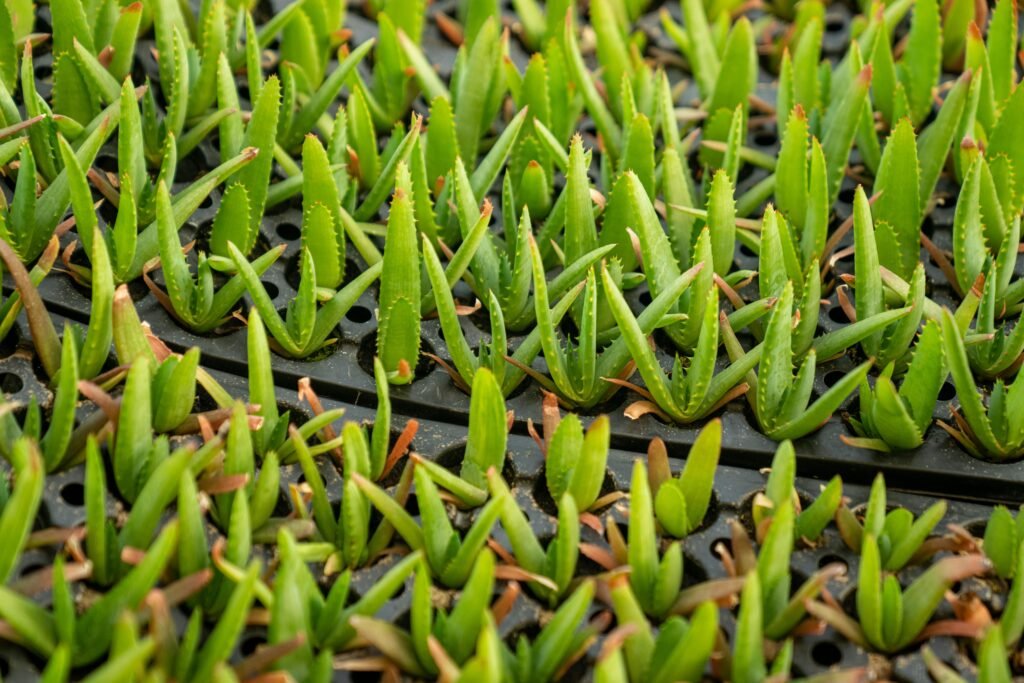
Propagation Techniques
The best way to propagate aloe vera is through offsets, or “pups,” that sprout at the base of mature plants. Carefully separate these pups and plant them in prepared soil, making sure to bury about two-thirds of the offset. Keep a spacing of 60×60 cm between plants to give them room to grow.
Watering & Irrigation
Aloe vera is quite drought-tolerant and doesn’t need a lot of water. Water deeply but infrequently, allowing the soil to dry out between waterings. Generally, 4 to 6 irrigations a year should do the trick. Just ensure there’s good drainage to avoid any water buildup.
Fertilization & Soil Enrichment
When preparing the land, mix in about 8 to 10 tonnes of farmyard manure per hectare. Before the final plowing, apply 35 kg of nitrogen, 70 kg of phosphorus (P₂O₅), and 70 kg of potassium (K₂O) per hectare. You can also add a top dressing of 35 to 40 kg of nitrogen later in the growing season. Plus, using 300 to 400 kg of neem cake per hectare can help keep termite problems at bay.
Pest & Disease Management
Aloe vera is generally resistant to pests, but it can sometimes face issues with termites and leaf spot diseases. Regularly check your fields and keep the soil moisture just right to help prevent these problems. If you notice leaf spots, consider spraying with suitable fungicides as a precaution.
Harvesting Guidelines
Begin harvesting mature leaves 8–10 months after planting. Use a sharp knife to cut the outermost 3–4 leaves at the base, ensuring minimal damage to the plant. Harvesting can be done every three months, with commercial yields starting from the second year and continuing up to five years.
Yield Expectations
Under optimal conditions and proper management, farmers can expect to harvest 15–20 tonnes of fresh aloe vera leaves per acre annually.
By implementing these advanced cultivation practices, you can enhance aloe vera growth and yield, making it a profitable venture even in marginal soils.
Conclusion
How to grow aloe vera requires a few key steps: proper potting with well-draining soil, adequate sunlight, and a careful watering routine to prevent overwatering. By selecting the correct container and location in your home, you can create an ideal environment for this resilient plant to thrive.
By understanding the specific light requirements and watering needs of this resilient succulent, you can foster a thriving plant that beautifies your home and serves various practical purposes. You grow aloe indoors, in pots, or through water propagation; the key lies in consistent care and attention.
FAQs
What is the secret to growing aloe vera?
The secret to successfully growing aloe vera lies in understanding its natural habitat and replicating those conditions as closely as possible.
How to maintain an aloe vera plant?
Maintaining an aloe vera plant is relatively easy, making it a popular choice for both novice and experienced gardeners.
